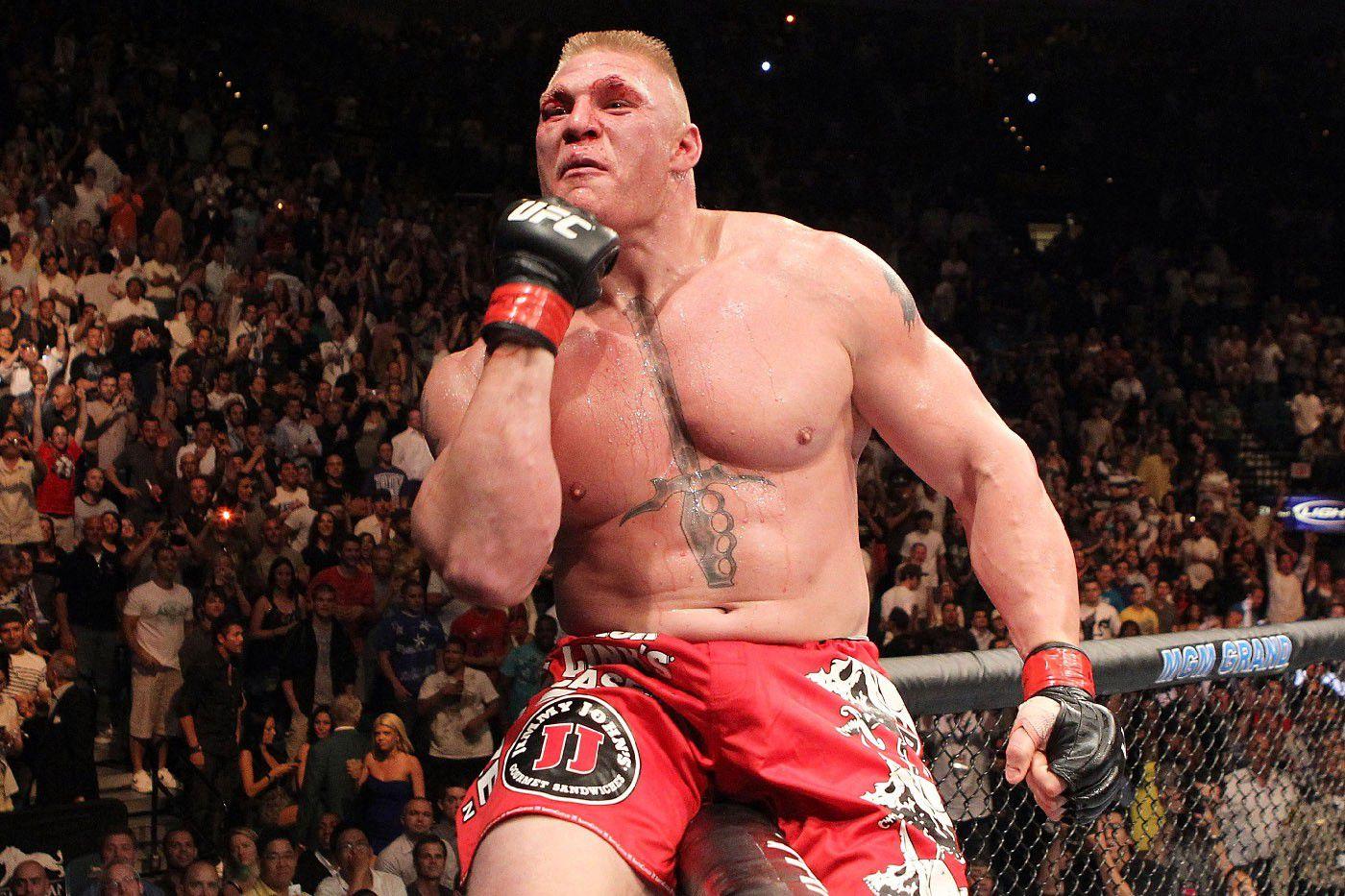Since he stalked back into the ring in April 2012, Brock Lesnar has been WWE’s biggest star. There’s really no question: His first move was F-5ing John Cena and then brutalizing him at the Extreme Rules PPV. He lost the match, but it hardly mattered; Cena and his aura of invincibility were a bloody mess. Lesnar followed that up by "breaking the arm" — twice — of company COO (and wrestler) Triple H, and "breaking the pelvis" of chairman Vince McMahon. He then dispatched with CM Punk, the Big Show, and, most shockingly, the Undertaker at WrestleMania 30.
Lesnar was at once WWE’s savior and its apocalypse. He was drawing in viewers and demolishing its legends one after another. And more significantly, he was deconstructing the art form one kimura lock at a time. Since McMahon turned pro wrestling into a cartoon sideshow in the ’80s, it’s been defined by its distance from the actual sporting world. When Lesnar reappeared after four successful years in the UFC, he brought a tidal wave of legitimacy — and the specter of real, brutal fighting — along with him. But none of this should’ve been a surprise.
When Lesnar first debuted on Raw in 2002 after an impressive college wrestling career, he was dubbed "The Next Big Thing" and beat the tar out of the beloved Jeff Hardy, then the beloved Hulk Hogan, and then the beloved Rock, en route to his first WWE championship. At 25, he was the youngest world champ ever, and he won the title faster after his WWE debut than anyone but Ric Flair, who was already in his 40s and a worldwide star when he was hired.
Lesnar bulldozed records and legends with a terrifying, dumbstruck sneer on his wide face. He left WWE in 2004 because he was tired of the peripatetic wrestling lifestyle, he missed the adrenaline of actual competition, and, one assumes, he had already accomplished all there was to accomplish in the wrestling ring. His last match, against Goldberg at WrestleMania 20, was booed loudly, because the fans knew both guys were out the door after that night.
After that, Lesnar tried out for the Vikings but was cut after training camp. He then eventually made his way to mixed martial arts, a field in which many former collegiate wrestlers were flourishing. In his first match, for K-1 in June 2007, he squashed Min Soo Kim like it was the opening match at a Nassau Coliseum house show.
What made his win over Kim so impressive — aside from it being his first pro fight — is that he won by strikes while being bear-hugged, which is not easy to do. But Lesnar was so massive and his arms were so long that he could get enough torque to break a man’s face at zero distance.
He upgraded to the UFC soon thereafter, and his first match came against former heavyweight champ Frank Mir in February 2008. He steamrolled Mir but got caught in an ankle lock and lost. It was a rookie mistake he wouldn’t make again. He slo-mo mauled Heath Herring, trampled over the legendary Randy Couture to win the promotion’s heavyweight championship, and got his revenge on Mir at UFC 100. He was the biggest star in UFC history four fights in. If his age and inexperience made his first WWE championship so impressive, UFC people were awed that a fake fighter was rewriting the rules in the real combat world.
Of course, UFC was eager to embrace him, even if some people sneered at the WWE crossover aspect of it. Lesnar was too much of a mythological figure to be ignored. Perhaps it was unsurprising that his downfall came as a curse from the gods. Almost as quickly as he had walked away from WWE, Lesnar dropped off the MMA map, sick with a ravaging intestinal infection called diverticulitis. After a first bout with the illness in 2009, he eventually limped into a comeback match against Shane Carwin at UFC 116 and spent the first round getting punched in the face before winning by a second-round submission. By the time he met Cain Velasquez a few months later, Lesnar’s shaggy beard couldn’t hide the fact that he was a few steps slow, and he lost on a first-round TKO.
Another bout of diverticulitis forced him to withdraw from a match against Junior dos Santos, and he lost his return match to Alistair Overeem in December 2011. Overeem, who would later test positive for elevated levels of testosterone, kicked him squarely in the gut, where he’d had a foot of intestine removed. But Lesnar wasn’t looking for a moral victory or to win on a technicality due to an opponent’s positive test. He retired from fighting that night.

When he resurfaced in WWE a few months later in 2012, the crowd went nuts, even graded on the curve of wrestling fans going nuts. He was the conquering hero returning home, but more than anything, he was a much-needed jolt of legitimacy for a company trying to find its way in an era in which so much of sports and pop culture had cribbed away all that made WWE unique. Putting a star of his magnitude in a position to win — even on the minimal schedule Lesnar negotiated upon his return — was a no-brainer. He was a quintessential wrestling monster, the itinerant bulldozer who would pop up to goose ticket sales at big events. What was shocking was that the WWE allowed a guy who had already walked out on the company once the honor of ending the Undertaker’s 21-match WrestleMania win streak in 2014. Maybe even more surprising than that: The WWE let him beat Cena — it let the monster become the champion — in the main event that year at SummerSlam.
When he lost the belt seven months later to Seth Rollins at WrestleMania in 2015, there were shenanigans involved (Rollins wasn’t even officially in the match), but just like in his Overeem fight, it was less about Lesnar’s loss than it was about the changing of the guard. Lesnar had brought UFC-style legitimacy to the WWE title, just as he’d brought a WWE-style hype machine to UFC. He was a crossover star who managed to somehow become more potent — more Brock — by doing whatever interested him at the time.
Last month, when he announced that he would be returning to UFC to fight at UFC 200 — that’s 109 PPVs since he won his first title — it shocked the wrestling and MMA worlds. The questions on the MMA side were numerous: Has he recovered enough to get back in the octagon? Would he be too rusty to fight at that level? Was he past his prime? But at least they were definable. The questions about his future in WWE were harder to pin down: What would happen to the biggest star in pro wrestling if he lost in UFC again?
Lesnar, for his part, gave the most Brock Lesnar answer possible: "I really don’t give a shit." He went on: "I don’t sit up at night wondering if my drawing power is going to be hurt [and] are my WWE fans going to tune and watch me do this. I don’t give two shits about that. This is about me. I want to get in there and be an athlete again."
With Jon Jones out of UFC 200 on Saturday, Lesnar is once again the main draw. He’s the biggest star in UFC again, despite not having fought a match for the promotion in nearly five years. And he’s the biggest star in WWE precisely because of what he does on the side. Who else could so cavalierly and openly not give a shit about his day job? Who else could negotiate with McMahon of all people with nothing but his will as a bargaining chip? "I think he knows a happy Brock Lesnar is easier to work with than a Brock Lesnar that’s not," Lesnar said.
Somehow, Lesnar is the face of both the WWE and UFC after both companies have spent a decade pretending they don’t have anything in common.

So what would a loss to Mark Hunt at UFC 200 mean for Lesnar’s WWE career? Not much, probably. He came back to WWE having lost three times in the UFC and managed to become a bigger star than he was before. Even a diminished Lesnar is probably the biggest star WWE has on its roster. (And if all else fails, there’s always the option to stage a rematch with Hunt at WrestleMania.) But if he wins? Well, that’s a whole different story. WWE reaps the benefit, and with Lesnar on the card, SummerSlam will probably be more popular than ever. He’ll probably go and do another UFC fight, and then come back to WWE again, until he can’t do one or both anymore, or until he decides to pack up and do something else entirely. Lesnar has never been able to sit still for long.
If he had stayed in UFC after 2011, he’d be over the hill, a special attraction at best. If he had never left WWE, he might be drawing yawns like his peers Cena and Randy Orton. By his refusal — or his inability — to settle down, Lesnar has kept himself viable. And, bizarrely, he’s become an anchor to both companies that he’s two-timing. The traditional rules don’t apply to Lesnar. Dana White can dismiss Lesnar’s viability and then make him a main eventer in his first match back. McMahon can make him the face of the company and then let him work for UFC. Fans complained when Cena beat Lesnar in that match in 2012, but it didn’t matter. Scripted wins and losses are secondary to Lesnar’s appeal.
So when he bulldozes into the octagon on Saturday, don’t think about whether he’s going to win or lose, and what it’s going to mean for his future. Before the fists start flying, before Hunt starts hurling missiles and we see what Lesnar has left, take a minute to remind yourself that he’s the reason you can’t take your eyes off the screen.
An earlier version of this piece said that Brock Lesnar beat Min Soo Kim by strikes from inside full guard; in fact, Lesnar beat Kim while being in mount.
